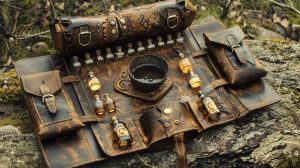Philtromancy
Philtromancy, commonly known as potion brewing, is a specialized discipline within the magical arts focused on the creation of potions, elixirs, ointments, and other concoctions imbued with magical properties. These substances are crafted to elicit specific magical effects, such as healing, enhancing abilities, inducing visions, or even levitation. Philtromancy stands distinct from alchemy, which primarily revolves around the transmutation and manipulation of substances at a fundamental level.
History and Practice
The practice of philtromancy dates back to ancient times, with roots in various cultures and magical traditions around the world. Ancient philtromancers were often revered as healers and seers, wielding their knowledge of herbs, magical ingredients, and arcane rituals to serve their communities. Over the centuries, the discipline has evolved, incorporating advances in magical theory and the discovery of new magical ingredients, yet the core principles of philtromancy—intuition, balance, and harmony with nature—remain unchanged.
Philtromancy relies heavily on the philtromancer's knowledge of magical flora, fauna, and other supernatural elements. Ingredients are chosen for their inherent magical properties and are often combined in precise ratios to achieve the desired effect. The process of brewing can vary greatly, from simple mixtures requiring little more than stirring and chanting, to complex recipes that demand specific environmental conditions, lunar phases, or even enchanted apparatus.
The applications of philtromancy are vast and varied. Healing potions are perhaps the most commonly sought-after, capable of mending wounds, curing ailments, or revitalizing the weary. Other concoctions might grant the imbiber enhanced senses, the ability to breathe underwater, or temporary immunity to magic. More esoteric brews can facilitate astral projection, unlock latent magical abilities, or serve as catalysts for powerful enchantments.
In contemporary magical society, philtromancy is both a field of academic study and a practical skill. Modern philtromancers are as likely to be found in the laboratories of magical universities as they are in the field, gathering rare ingredients or researching new potion formulas. The discipline continues to evolve, with innovative philtromancers pushing the boundaries of what is possible through the magical infusion of liquids.
Philtromancy remains a vital and vibrant aspect of the magical arts, bridging the gap between ancient traditions and modern magical practice. Its ability to harness the inherent magic of the natural world and channel it into tangible, beneficial forms ensures that the art of potion brewing will continue to be a cherished and respected craft for generations to come.
Distinction from Alchemy
While both philtromancy and alchemy involve the manipulation of substances to achieve extraordinary outcomes, the two disciplines are fundamentally different in their goals and methods. Alchemy, with its focus on transmutation and the pursuit of the Philosopher's Stone, is a more philosophical and elemental practice. In contrast, philtromancy is pragmatic, centered on creating tangible, immediate effects through the combination of magical ingredients.
Philtromancy vs Magic
Students often question the viability of philtromancy, considering any effects achieved by potions could also be achieved through spells, often more easily and comfortably. However, while there may be some overlap in their effects, spells and potions served different purposes and offer unique benefits. They have distinct characteristics that make them valuable in different positions.
- Potions often have a longer-lasting effect compared to spells. For example, one potion's effects may last for an hour, while a spell might require constant recasting or concentration to maintain the effect.
- Potions can be used by individuals who might not have the same level of magical skill or knowledge as required to cast a complex spell. They can be prepared in advance and used by someone other than the potion-maker, making them more versatile and convenient in certain situations.
- While some effects may be easier to achieve through spells, others are not. A simple healing potion is easily crafted, it is generally the first potion first-year students learn. However, healing magic is inherently difficult, even the simplest healing spell should not be attempted by someone without proper practice, discipline and control.
- Potions can be ingested or applied discretely, making them useful in situations where using a wand or casting a spell might draw unwanted attention.
- Some potions are incredibly powerful and have effects that might not be achievable through spells. Potions can also be customized to suit specific needs or strengths, making them more potent for certain purpose.
- Potions can be used in combination with spells to enhance or modify their effects. For example, a potion might be used to boost a wizard's magical abilities, making their spells more effective.
- The world is rich in magical traditions, and potion-making is an essential part of that tradition. The existence of both potions and spells provides a more diverse and versatile magical landscape, allowing characters to choose the most suitable method for their needs. It's not bad to have multiple ways to choose from to achieve your goal.
Types of Potions
Any product of philtromancy has a liquid base. There are four primary bases.
Water
Water-based products are called aquasols. These are generally the easiest types of potions to make. The water-base allows for quick absorption into the body and ensures that the potion's properties take effect rapidly. Examples of aquasols are:
- Aurora Wine - a delectable recreational drink that lets one breathe aurorae.
- Magic Ink - a type of ink with magic properties which can be used for Gyokumeiga.
- Meld-All Mixture - a simple and easy to create healing potion.
Oil
Oil-based products are called oleums. Most ointments are oleums. Oils provide a more viscous consistency that can easily applied to skin, clothes, or other surfaces. Examples of oleums are:
- Fire Protection Salve - allows one to cover a surface and make it completely immune to the effects of heat and fire.
- Flight Salve - a type of ointment used to temporarily give objects the ability of flight.
Milk
Milk-based products are called lactescences. These are relatively rare. The Milk base allows for smooth blending of a potion's various ingredients, helping to create a stable and effective draught. Milk-based potions are the most difficult to create. Examples of lactescences are:
- Dreamless Sleep Draught - plunges whoever drinks it into a deep, dreamless sleep.
- Novilunium Potion - a potion to suppress the female menstruative cycle, also acting as a contraceptive without any negative side-effects.
- Star Milk - a pleasant-tasting, sleep-inducing draught.
- Warming Potion - consuming this potion makes one immune to the cold. Note that this potion provides no immunity to ice-based spells.
Alcohol
Alcohol-based products are called elixirs. These are among the strongest of potions. Alcohol is an efficient solvent for extracting and preserving the active ingredients from various plants and herbs. It also has the ability to rapidly enter the blood stream when consumed. However, one must be careful not to comsume too much elixir at once, due to the intoxicating effects of alcohol. Most elixirs are thus not suitable for children. Examples of elixirs are:
- Aurora Elixir - an alcoholic version of Aurora Wine.
- Elixir of Life - a fabled elixir that supposedly prolongs life and restores youth.


